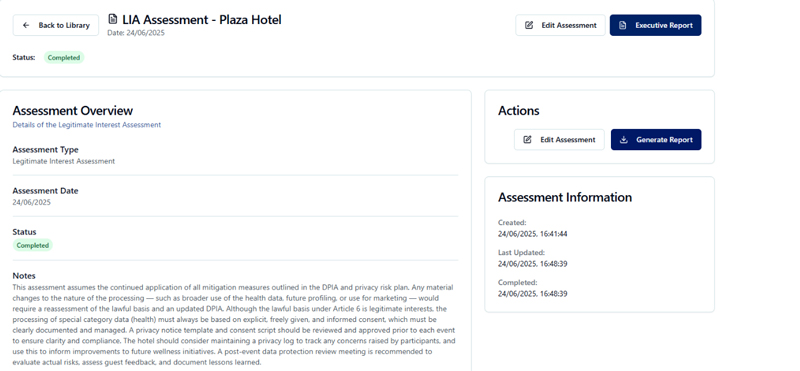Beyond Creation: The Operational Burden of Managing & Reviewing Manual Legitimate Interest Assessments
1. In our previous article, we explored the significant hurdles involved in merely creating Legitimate Interest Assessments (LIA's) using generic document tools. While those initial challenges are substantial, they pale in comparison to the operational burden and escalating compliance risks that emerge when attempting to manage and continuously review these crucial assessments throughout their lifecycle. An LIA isn't a static document; it's a living record that requires ongoing attention to remain valid and compliant. Without a dedicated privacy management platform, organisations often find themselves caught in a perpetual struggle for control and clarity.
The Profound Difficulties of Lifecycle Management Without a Compliance Platform
2. The true test of a privacy program lies in its ability to sustain compliance over time. For LIA's, this means processes for initiation, tracking, review, approval, and adaptation. Manual systems notoriously fail at these critical junctures.
Unstructured Initiation & Assignment
3. How does your organisation trigger a new LIA when a new processing activity or project is initiated? In a manual environment, this often relies on informal communication, memory, or ad-hoc requests. There's no clear, automated workflow to ensure that every new data processing activity relying on legitimate interest is promptly identified, an assessment is assigned, and its progress is tracked from day one. This unstructured approach significantly increases the risk of missed assessments, leaving potential compliance gaps and exposing the organisation to unknown liabilities.
Lack of Workflow & Progress Tracking
4. Once an LIA is initiated, tracking its progress becomes another immense challenge. There's no centralised dashboard or automated system to show whether an assessment is in draft, awaiting legal review, approved, or pending an update. Teams often resort to disparate spreadsheets, informal email updates, or even physical notes, which are prone to becoming outdated instantly. This loss of visibility creates bottlenecks, delays projects, and prevents DPOs from understanding the overall compliance posture of legitimate interest processing across the organisation.
Review and Approval Bottlenecks
5. The review and approval process for LIA's is often a multi-stakeholder exercise, involving business units, legal teams, and DPOs. In a manual setup, this means circulating documents, collating feedback from numerous email threads, resolving conflicting comments, and chasing down signatures. This leads to prolonged approval cycles, delaying critical business initiatives and potentially pushing teams to proceed with processing before an LIA is formally approved, risking non-compliance. Furthermore, establishing a clear, auditable trail of who approved what and when becomes incredibly difficult.
The Challenge of Periodic Review & Re-assessment
6. A fundamental principle of data protection is that LIA's are not "set it and forget it" documents. They require regular review and potential re-assessment, especially when there are changes in the processing activity, the data collected, the legal landscape, or the organisational context. Manually tracking due dates for hundreds or thousands of LIA's is an administrative nightmare, often leading to stale or outdated assessments. Relying on an outdated LIA, particularly during a regulatory audit, can be as detrimental as not having one at all.
Limited Reporting & Executive Oversight
7. Without a centralised system, generating consolidated reports on your legitimate interest processing activities is virtually impossible. DPOs cannot easily gain insights into the total number of LIA's, their associated risk levels, the status of pending assessments, or overall compliance trends. This lack of aggregated data severely hampers executive oversight, making it difficult for senior management to identify systemic risks, allocate resources effectively, or demonstrate robust governance to boards and regulators.
Failure to Capture Lessons Learned
8. Every LIA provides valuable insights into privacy risks, effective safeguards, and areas for process improvement. However, in a manual environment, there's no systematic way to document and disseminate these "lessons learned." Each new LIA often starts from scratch, leading to duplicated effort, inconsistent application of best practices, and a missed opportunity for continuous improvement in the privacy program. This also means a significant risk of knowledge loss when experienced privacy professionals move on.
Conclusion:
9. The cumulative effect of these operational challenges is not merely inconvenience; it's a significant exposure to legal, financial, and reputational risks. Manual management of Legitimate Interest Assessments creates a brittle, inefficient, and non-auditable privacy framework that is unsustainable for any organisation committed to robust data protection.
10. The good news? This chaotic reality doesn't have to be your future. In our final article in this series, we will introduce a transformative solution – Privacy360 and its dedicated Legitimate Interest module – demonstrating how a purpose-built platform can bring unprecedented clarity, control, and confidence to your privacy management efforts.


